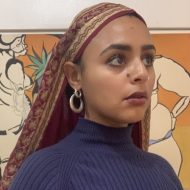Having a teaching practice which is rooted in working with children with SEN over the past three years has given me the opportunity to broaden my perspective on different ways of teaching. It has enabled me to become a more patient and empathetic person overall. Moreover, it has shown me that in order to reach my students and aid in their growth, understanding and development, I need to do the work keep myself informed of their needs and requirements.
When watching the clip about Christine Sun Kim’s art, I felt very moved when she stated, “I want to explore sound without a mediated interpretation of what sound is. I want to find its meaning through my experience.” There are issues that need to be addressed concerning how information is prescribed by the preexisting curriculum and how it is mediated through the educator to the student. I am asking the question; How I can help empower my students and give them space to generate meaning from their own experiences? Christine’s praxis is about reclaiming and embodying sound through experimentation with different materials that react to the movement of the vibrations. Where sound is translated into movement, shape and colour. There is ‘felt’ quality to her art. It made me think about how teaching can be very prescriptive/ directive when it could be explorative/ reflective. I want to adopt somatic learning approaches into the way I teach.
Somatic derives from the greek word Somakitos which translates to “of the body” hence somatic learning involves the whole body as an intelligent vessel and engages all the senses in the learning process as opposed to models that are fixated on the mind as the penultimate decoder of knowledge. The framework for somatic learning begins with attentive focus from present participants. A physical sensation is stimulated which evokes an emotion, bringing together the mind and body. There is a chance for deep empathic listening and discernment then words follow to describe the learning experience.
If a student disclosed their disability status to me it would be a duty to refer them to UAL’s Disability Service where they will be better supported throughout their course. Even before any disclosure, it is best to share the knowledge that there is a specialised team of UAL staff (i.e Disability Advisors) that are solely there to support the needs of disabled students. Sharing this resource would mean that students with disabilities have the means to identify the barriers to their education and action forth adjustments and support needed to remove said barriers. They could also be eligible to receive funding as well as identify the necessary equipment/ assistive software to better support them during their time of study. Being transparent about the avenues of help and support is integral to me because it leads back to a fundamental guiding principal to the way I operate as an educator, namely that there is a duty of care towards the people I work with and teach.
While reading Disabled People: The voice of Many, I picked up on the ethos of The New Radical Model
“If the disability movement doesn’t recognise and prioritise the experience of disabled people of colour, working class, refugees and asylum seekers and so on, then it is not truly a movement concerned with justice. Justice for all groups, therefore, is bound up in the same struggle.” https://issuu.com/shadesofnoir/docs/disabled_people (pp. 14-15)
This statement considers the intersections of a person’s identity. To be an advocate for the disabled is to take into consideration all of the nuances and multitudes that inform a persons idea of selfhood and not see them as mutually exclusive. This form of activism is embodied by the creator of the DisabilityTooWhite hashtag, Villissa Thompson who called out the whitewashing of disability. Who saw a lack of representation of disabled people of colour in media and decided to elevate marginalised voices by speaking out against it. By bringing awareness to an ableist society which does not account for people of colour in its narrative of history, she is advocating for critical reforms in attitudes which serve to disempower and erase.
